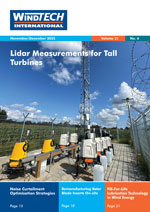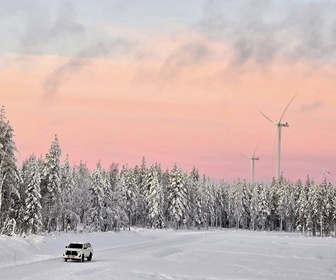- Category: Articles
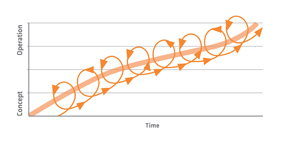 According to Pertti Kurttila from The Switch, today’s businesses need to constantly build on uncertainty. They need to be ready and responsive to continual market changes. The customer and supplier need to create a tight-knit team, constantly taking small steps in the same direction in order to engineer tomorrow’s wind technology. In this article, Mr Kurttila explains ‘agile positioning’ and how The Switch has used this concept to refine its business model.
According to Pertti Kurttila from The Switch, today’s businesses need to constantly build on uncertainty. They need to be ready and responsive to continual market changes. The customer and supplier need to create a tight-knit team, constantly taking small steps in the same direction in order to engineer tomorrow’s wind technology. In this article, Mr Kurttila explains ‘agile positioning’ and how The Switch has used this concept to refine its business model.- Category: Articles
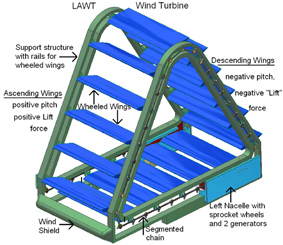 The industry gold standard is the three-bladed, horizontal axis wind turbine (HAWT), but one has to wonder why. As explained below, HAWTs come with many inherent problems. EverLiftWind Technologies have been investigating an alternative based on a fixed-wing type airfoil, and in this article Peter Keller describes the company’s new concept, the Looped Airfoil Wind Turbine or LAWT.
The industry gold standard is the three-bladed, horizontal axis wind turbine (HAWT), but one has to wonder why. As explained below, HAWTs come with many inherent problems. EverLiftWind Technologies have been investigating an alternative based on a fixed-wing type airfoil, and in this article Peter Keller describes the company’s new concept, the Looped Airfoil Wind Turbine or LAWT.- Category: Articles
 March 2013 saw the tenth anniversary of the first commercial lidar deployment for wind energy applications – and while it is now commonplace to see wind lidars (such as ZephIR 300 and those that followed) in wind energy resource assessments, it was actually a turbine-mounted application for which the ZephIR technology was first deployed. Ten years on, and ZephIR’s continuous-wave (CW) lidar technology continues to be developed and is now gaining increasing acceptance in its original application of optimising wind turbine generator performance. This acceptance is founded on a body of evidence from ground-based operation spanning some 650+ deployments, 3.5 million operating hours and recent comprehensive comparative trials of 79 ZephIR 300s against an IEC-compliant met mast as part of an industry accepted validation process with banks’ engineers such as Natural Power and GL Garrad Hassan.
March 2013 saw the tenth anniversary of the first commercial lidar deployment for wind energy applications – and while it is now commonplace to see wind lidars (such as ZephIR 300 and those that followed) in wind energy resource assessments, it was actually a turbine-mounted application for which the ZephIR technology was first deployed. Ten years on, and ZephIR’s continuous-wave (CW) lidar technology continues to be developed and is now gaining increasing acceptance in its original application of optimising wind turbine generator performance. This acceptance is founded on a body of evidence from ground-based operation spanning some 650+ deployments, 3.5 million operating hours and recent comprehensive comparative trials of 79 ZephIR 300s against an IEC-compliant met mast as part of an industry accepted validation process with banks’ engineers such as Natural Power and GL Garrad Hassan.- Category: Articles
 Although the costs of a wind measurement campaign are quite small when compared to the overall investment needed to construct a wind farm, many developers still try to save some thousands of euros by using smaller met masts and cheap sensors. But does this strategy pay off? Or, in other words, what is gained by a high quality wind measurement? To answer these questions this article compares two scenarios. Scenario 1 has an IEC standard tower, first class sensors and measurement at hub height. Scenario 2 assumes inappropriate (cheap) sensors, bad design and measurement somewhat below hub height. All other conditions (turbine type, location, terrain, obstacles, etc.) are assumed to be exactly the same, in order to estimate the effect of the different measurement regimes. The energy yield is calculated by adding the respective uncertainties a consultant would estimate for the respective measurements, so that the two scenarios can be compared in financial terms and then be related to the cost of high quality measurement.
Although the costs of a wind measurement campaign are quite small when compared to the overall investment needed to construct a wind farm, many developers still try to save some thousands of euros by using smaller met masts and cheap sensors. But does this strategy pay off? Or, in other words, what is gained by a high quality wind measurement? To answer these questions this article compares two scenarios. Scenario 1 has an IEC standard tower, first class sensors and measurement at hub height. Scenario 2 assumes inappropriate (cheap) sensors, bad design and measurement somewhat below hub height. All other conditions (turbine type, location, terrain, obstacles, etc.) are assumed to be exactly the same, in order to estimate the effect of the different measurement regimes. The energy yield is calculated by adding the respective uncertainties a consultant would estimate for the respective measurements, so that the two scenarios can be compared in financial terms and then be related to the cost of high quality measurement.- Category: Articles
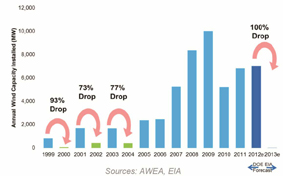 Despite impressive gains in the amount of wind power production during the last four years and the benefits this has brought, the financial statements of wind turbine manufacturers and related businesses have shown large losses over the same period and it is difficult for smaller investors to get a good return on investments in renewable energy. Maybe we need a radical rethink. In this article, Mike J. Fritz presents his arguments for the kilowatt-hour as a new monetary unit and standard. He also provides the text of the Renewable Power to the People Amendment, which he suggests, if supported and successful in the USA, could set the stage for other countries to follow.
Despite impressive gains in the amount of wind power production during the last four years and the benefits this has brought, the financial statements of wind turbine manufacturers and related businesses have shown large losses over the same period and it is difficult for smaller investors to get a good return on investments in renewable energy. Maybe we need a radical rethink. In this article, Mike J. Fritz presents his arguments for the kilowatt-hour as a new monetary unit and standard. He also provides the text of the Renewable Power to the People Amendment, which he suggests, if supported and successful in the USA, could set the stage for other countries to follow.- Category: Articles
Wind Turbines, Energy Containers and Microgrids
 An energy container is a mobile hybrid power supply system built into a container. Much of the past use and development of energy containers has been for military purposes, but they can also be used for civilian purposes, for example in remote areas as the energy supply of base stations (cells) for mobile telephony or to provide the energy needs of remote villages. Basically, an energy container is a container equipped with solar panels, a wind generator, a diesel generator, batteries and an energy management system, although these can be arranged in a number of different configurations. In this article Frits Ogg presents an overview of the capabilities, market and applications of energy containers, with particular emphasis on the role of the wind turbines to be found within them.
An energy container is a mobile hybrid power supply system built into a container. Much of the past use and development of energy containers has been for military purposes, but they can also be used for civilian purposes, for example in remote areas as the energy supply of base stations (cells) for mobile telephony or to provide the energy needs of remote villages. Basically, an energy container is a container equipped with solar panels, a wind generator, a diesel generator, batteries and an energy management system, although these can be arranged in a number of different configurations. In this article Frits Ogg presents an overview of the capabilities, market and applications of energy containers, with particular emphasis on the role of the wind turbines to be found within them.
By Frits Ogg, Renewable Energy Consultant, The Netherlands
- Category: Articles
Some Results and Conclusions
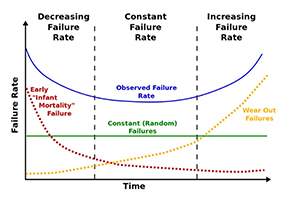 This article focuses on historical component failure and the availability of replacements in both onshore and offshore wind farms. It also looks at techniques available to calculate the effect of mean time between failure of critical components and mean time to repair and how such techniques can be applied to all projects. It considers the impact of failures on year-to-year availability, the sufficiency of contractual warranties, financial planning for repairs and current best practice operation and maintenance (O&M) strategies for projects. This includes evaluating what proactive measures can be taken and how condition monitoring techniques can improve mean time to repair times.
This article focuses on historical component failure and the availability of replacements in both onshore and offshore wind farms. It also looks at techniques available to calculate the effect of mean time between failure of critical components and mean time to repair and how such techniques can be applied to all projects. It considers the impact of failures on year-to-year availability, the sufficiency of contractual warranties, financial planning for repairs and current best practice operation and maintenance (O&M) strategies for projects. This includes evaluating what proactive measures can be taken and how condition monitoring techniques can improve mean time to repair times.
By Steve Buckley, Team Leader, Sinclair Knight Merz, UK
Windtech International wants to make your visit to our website as pleasant as possible. That is why we place cookies on your computer that remember your preferences. With anonymous information about your site use you also help us to improve the website. Of course we will ask for your permission first. Click Accept to use all functions of the Windtech International website.



